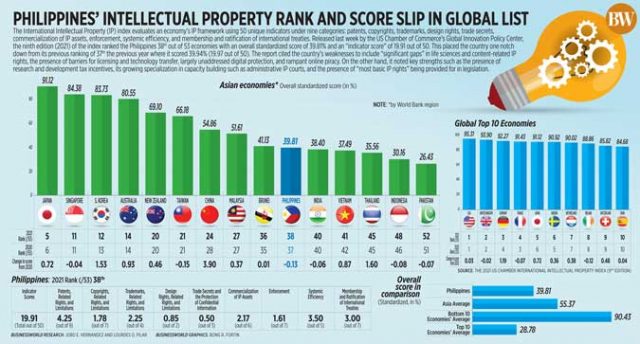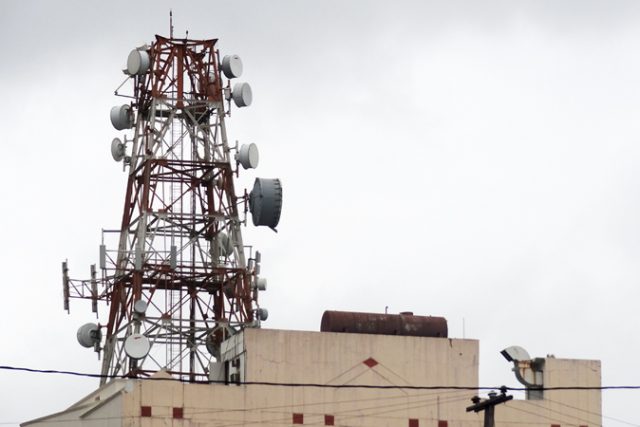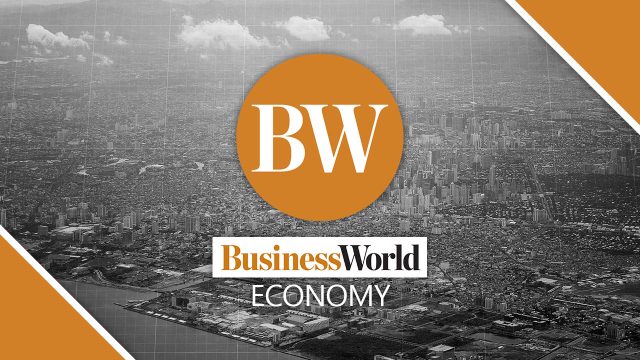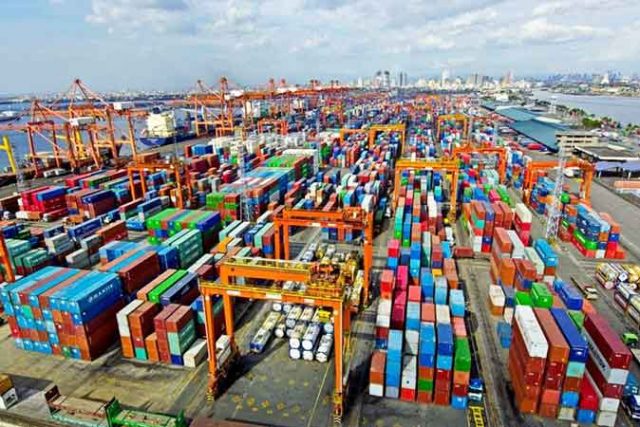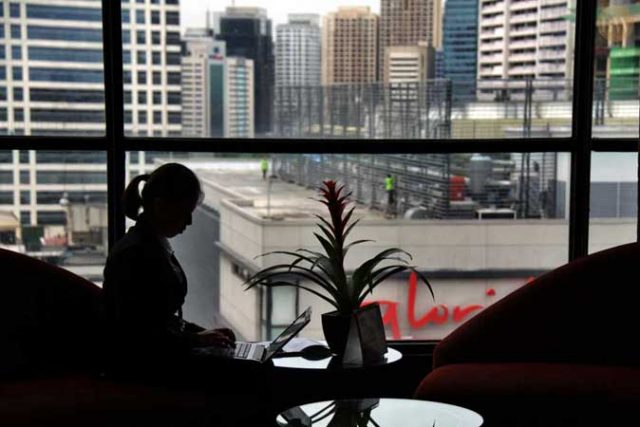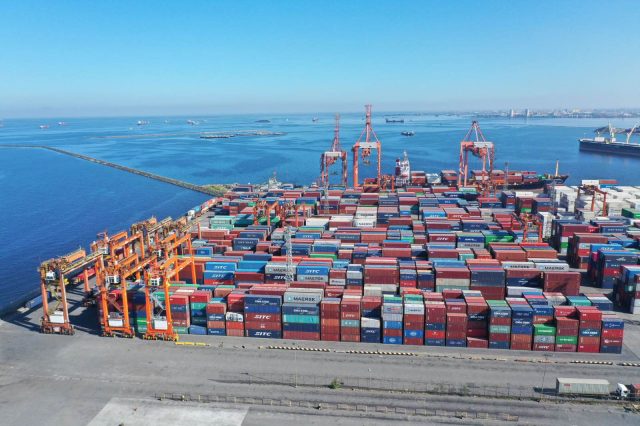PSE index rises on hopes of economic recovery
STOCKS continued to rise on Wednesday on investor optimism following the slower inflation print recorded last month.
The Philippine Stock Exchange index (PSEi) rose by 61.6 points or 0.93% to close at 6,651.71 on Wednesday, while the broader all shares index went up by 41.94 points or 1.04% to 4,044.94.
“Investors chose to be optimistic despite concerns of an extended lockdown due to surging COVID-19 (coronavirus disease 2019) cases,” AAA Southeast Equities, Inc. Research Head Christopher John Mangun said via e-mail.
“Inflation figures for the month of March, which came in lower than the month before, has given investors some hope that prices of commodities have started to stabilize, soothing fears of runaway inflation which would hurt the struggling economy further. The lack of selling prompted bargain hunters to look for opportunities in battered issues,” Mr. Mangun added.
Headline inflation was at 4.5% in March, the Philippine Statistics Authority reported on Tuesday, slowing from the 4.7% print in February but faster than the 2.5% seen in March last year.
Inflation averaged at 4.5% for the first quarter, beyond the central bank’s 2-4% annual target as well as its 4.2% forecast for 2021.
Meanwhile, Timson Securities, Inc. Trader Darren T. Pangan said the gains posted by the PSEi also reflected offshore developments.
“The market ended higher together with most Asian markets, on growing optimism over the world’s economic recovery, especially after the IMF (International Monetary Fund) lifted their outlook on their global growth forecast,” Mr. Pangan said in a Viber message.
Majority of the PSEi’s sectoral indices went up on Wednesday, except for mining and oil, which dropped by 53.09 points or 0.61% to 8,529.01.
Meanwhile, property gained 81.42 points or 2.52% to 3,312.83; holding firms improved by 43.71 points or 0.64% to finish at 6,800.23; industrials went up by 44.66 points or 0.5% to 8,935.95; services increased by 5.59 points or 0.39% to 1,439.22; and financials inched up by 5.3 points or 0.38% to close at 1,390.04.
Value turnover decreased to P6.05 billion on Wednesday with 3.41 billion shares switching hands, from the P5.85 billion with 2.42 billion issues traded on Tuesday.
Advancers outnumbered decliners, 147 against 57, while 46 names closed unchanged.
Net foreign selling climbed to P667.2 million on Wednesday from P551.88 million in the previous trading day.
“Thursday being the last trading day of the week, significant support may be drawn at the 6,400 area, while next resistance may be set at the 6,950 level,” Mr. Pangan said. Financial markets are closed on Friday in observance of the Day of Valor.
“PSEi is currently up 3.2% for the week, and although we may see some profit taking on the last trading day, it may still end with some gains for the week,” AAA Southeast Equities’ Mr. Mangun added. — Keren Concepcion G. Valmonte
Peso declines vs dollar on lockdown concerns
THE PESO closed sideways against the greenback on Wednesday as the market awaits clarity on restrictions on movement after this week and new signals from the US Federal Reserve.
The local unit closed at P48.585 per dollar on Wednesday, depreciating by 1.5 centavos from its P48.57 finish on Tuesday, data from the Bankers Association of the Philippines showed.
The peso opened yesterday’s trading session at P48.53 versus the dollar. Its weakest point was at P48.625, while its intraday best was at P48.52 against the greenback.
Dollars exchanged inched up to $581.8 million on Wednesday from $559.3 million on Tuesday.
The peso depreciated slightly amid concerns over the possibility of an extension of the tight restriction measures currently in effect in Metro Manila and nearby provinces, Rizal Commercial Banking Corp. Chief Economist Michael L. Ricafort said.
Presidential Spokesperson Herminio “Harry” L. Roque on Tuesday said the government is not keen on extending the strict lockdown in these areas, saying the government lacks funds for cash aid.
Mr. Roque said they are instead considering the recommendation of the Department of Health to switch to a modified enhanced community quarantine after the two weeks of strictest form of lockdown in the National Capital Region, Cavite, Laguna, Rizal, and Bulacan.
However, President Rodrigo R. Duterte on Wednesday skipped his weekly address to the nation on the coronavirus disease 2019 (COVID-19) situation in the country and the Palace did not provide further explanation regarding his absence.
COVID-19 infections rose 6,414 on Wednesday to bring the total to 819,164, with active cases now at 158,701.
Meanwhile, a trader said the peso inched down versus the dollar due to “some caution ahead of the release of the Fed policy minutes.”
The Federal Reserve was expected to release the minutes from its last monetary policy meeting later on Wednesday, and market participants were set to parse it for any changes to the US central bank’s economic outlook, Reuters reported.
The US economy is heading for its strongest growth in nearly 40 years, the Fed said after its meeting last month, and central bank policy makers are pledging to keep their foot on the gas despite an expected surge of inflation.
Fed officials expect economic growth to remain above trend for at least two years to come, at 3.3% in 2022 and 2.2% in 2023, compared with estimated long-term potential growth of just 1.8%.
Opinions among the Fed’s 18 current policy makers did shift somewhat, with four now expecting rates may need to rise next year and seven seeing a rate increase in 2023.
Fed Chair Jerome Powell noted the “strong bulk” of the policy-setting Federal Open Market Committee (FOMC) anticipates no interest rate increase until at least 2024, and he added that it was even too soon to talk about scaling back the $120 billion of Treasury bonds and mortgage-backed securities the Fed is buying each month to further prop up the economy.
The FOMC’s policy statement, which kept the benchmark overnight interest rate in a target range of 0-0.25%, was unanimous.
Mr. Ricafort expects the peso to trade from P48.54 to P48.64 versus the dollar today, while the trader expects the local unit to move within the P48.50 to P48.70 levels. — LWTN with Reuters
Road right-of-way order seen easing cell tower construction
CELLULAR TOWER construction is expected to accelerate after the Department of Public Works and Highways (DPWH) issued a department order granting telecommunications firms use of the government’s right of way on national roads, Globe Telecom, Inc. said.
The order authorizes telcos “to construct and undertake excavations and/or restoration works” for information and communications technology infrastructure projects within the “allowable ROW (right of way) limits” of the national roads.
“With this, Globe sees faster network builds in the country after the government removed a major bottleneck that prevented telecom service providers from constructing crucial infrastructure projects along national roads,” the company said in a statement Wednesday.
Public Works Secretary Mark A. Villar issued Department Order No. 29 on March 23 “to facilitate the erection of infrastructure that will allow speedy expansion of telecommunication services and facilities while ensuring public safety, availability of government’s ROW, and the structural integrity of roads and bridges.”
The order lapses after three years.
According to Globe, the DPWH banned telcos in 2014 from erecting posts along national roads, citing the “imminent danger to lives and properties and hamper relief operations” during calamities.
“In October 2020, both the Department of Information and Communications Technology and the National Telecommunications Commission asked the DPWH to consider the proposed changes to the previous department order,” it added.
Globe said the restrictions “slowed down the rollout of critical telco infrastructure amid the rising demand for affordable, quality, and reliable” internet. — Arjay L. Balinbin
Economic team preparing to fund aid for prolonged lockdown
ECONOMIC MANAGERS are studying sources of funds for a fresh cash aid program in the event that the lockdown imposed on the capital region and nearby provinces is extended once more or expanded to more areas.
Budget Secretary Wendel E. Avisado confirmed that the economic team is studying funding for another round of cash aid if called on to do so in a third stimulus bill.
Budget Undersecretary Laura B. Pascua has said that the Development Budget Coordination Committee (DBCC) approved a new cash aid program but did not authorize a breach of the deficit cap, set at the equivalent of 8.9% of gross domestic product (GDP).
Mr. Avisado made the remarks at the Kapihan sa Manila Bay forum Wednesday.
Mr. Avisado said possible funding sources are realigned agency budgets, the early remittance of dividends from government-owned and -controlled corporations (GOCCs), and other sources that can be tapped by the Department of Finance (DoF).
The proceeds will support another stimulus bill following the passage of the Bayanihan I and II laws last year, but added that the size of the aid program will be subject to funding availability.
“What about the other regions who may yet to experience the same kind of reclassification later on (who were not given the P1,000 cash aid). That’s the thing we’re also preparing for and by then, we would be needing the assistance of Congress for an enabling law similar to Bayanihan I and II,” he said.
“We’re trying to really look at what would be the approximate amount the DoF can raise and those that we can also gather from available funds from various National Government agencies to help finance a Bayanihan III law,” he added.
GOCCs remitted a combined P21.44 billion worth of dividends to the Treasury in the first quarter as state-owned firms remitted their dividends ahead of schedule.
The DoF last week raised the equivalent of P24 billion from a three-year Samurai bond issue and is planning to tap the US bond market soon before rates rise.
Mr. Avisado said the economic team is also working on an Executive Order that will instruct agencies to reduce nonessential expenses, similar to instructions issued last year.
Much of the redirected funds are likely to come from budgets for maintenance and other operating expenses, including money for travel and seminars, as well as the cancellation of programs not yet implemented.
Mr. Avisado said funds for the flagship Build, Build, Build program will not be reduced because infrastructure projects are deemed important in driving the economic recovery. The government budgeted P1.2 trillion for infrastructure projects this year, out of an overall P4.5-trillion spending plan.
He said the overriding goal is to keep the sovereign credit rating in the middle of the pack in the region, in order to keep borrowing costs low.
“We are also very much concerned about our capability to ensure that our economy gets going. It cannot just be that we’re putting all our energies into health but (strike a balance) to ensure that our economy is still moving ahead,” Mr. Avisado said.
The lockdown in Metro Manila, Bulacan, Cavite, Laguna and Rizal was extended for another week to April 11 after daily coronavirus cases surged past the 10,000 level. A further extension of the enhanced community quarantine is unlikely and restrictions in these areas will likely be eased next week, the Palace has said.
Economic managers expect the two-week lockdown to have set back GDP growth by about 0.8 percentage points, to below the official projected range.
The DBCC has set a 6.5-7.5% growth target for this year and projected 8-10% growth in 2022. The economy contracted by a record 9.5% in 2020 as the Philippines implemented one of the world’s longest and strictest lockdowns. — Beatrice M. Laforga
Business solutions costs falling as digitization gains momentum
DIGITAL BUSINESS solutions are becoming cheaper in the so-called “new normal” as businesses continue to digitize their processes, a technology industry executive said.
“In general, if you wanted to invest in software 10 years ago, when we started the business, you really had to be ready with millions of pesos. It used to be very costly because you had to hire developers, ask them to customize software for you, purchase your own servers, and stuff like that,” said Maria Rosario Palabrica-Ilao, founder and chief executive officer of MobileOptima, Inc., the technology company behind Tarkie, an enterprise solution designed for field force automation.
“Technologies in general are now becoming more and more affordable,” she said at the BusinessWorld Insights online forum Wednesday.
With Tarkie, which is a SaaS or software as a service application, small businesses can start down the path of automation for as little as P1,500 per month, according to Ms. Ilao.
She noted that SaaS applications are becoming more popular these days because of low cost, ease of use, and can come off the shelf.
“They are plug and play, you can get started right away, and there’s no upfront cost as you don’t have to spend for software development, and you don’t have to purchase your own servers because typically all of these are already packaged in the monthly subscription,” Ms. Ilao explained.
Jerome Matthew Animos, field applications engineer at ASUS Philippines Commercial, said that pricing will depend on the technology needed.
“It’s going to be a different ball game if you compare it to Ms. Rio’s proposition. On our end, we ask first what the employees do and who are involved in the procurement process. So we need to ask them the right set of questions before we give them something in detail, because we don’t want our customers to get shocked with the pricing and everything,” he said.
“We give them a certain tier of devices that we actually offer to them to give them a better insight. In my presentation, normally, I show the good and better devices to give them an insight based on their workflow,” Mr. Animos added.
ASUS’s centralized information technology management system and personal computer-based management platform are two of the company’s digital solutions for businesses.
Mr. Animos expects that in the next decade, artificial intelligence of things or AIoT will become more widely used. AIoT, he said, is a combination of AI technologies with IoT that is intended to enhance human-machine interactions, data management, and analytics.
“Blockchain technology will become standard in day-to-day operations, from the simple time-in/time-out or even paying for your cup of coffee using cryptocurrency,” Mr. Animos added.
Ms. Ilao said, “I think it will only get better. I think the prospects are very promising. As we’ve mentioned, companies now in general have become more cognizant of the benefits of digitization. So definitely, more and more companies will embrace IT optimization and digital transformation in the next few years.”
“Gone are the days when big companies would prefer custom-built software. They would rather go for something that’s readily available, or something that’s plug and play. Small- and medium-sized enterprises in general are going to benefit from that,” Ms. Ilao added. — Arjay L. Balinbin
Overstaying cargo disposals generate over P138M in Q1
THE Bureau of Customs (BoC) said it generated P138.7 million from the disposal of 586 overstaying containers in the three months to March, part of an overall effort to decongest the ports.
In a statement Wednesday, the BoC said it sold 354 containers at auction while condemning 232 others.
“Significantly, these disposition activities are aimed at efficiently facilitating trade by eliminating port and yard congestion, thereby ensuring smooth flow of business within the agency,” the BoC said.
The agency issued Circular Memorandum Order No. 10-2020 in April 2020, declaring that cargo in ports and yards found to have overstayed more than 30 days from the date of discharge will be classified as abandoned.
Disposals helped make way for incoming shipments of critical goods, including food, medical items and personal protective equipment.
The BoC is authorized by law to donate, declare for official use, or sell at auction seized or abandoned items. Food, clothes, medicine and other goods that are suitable for shelter can also be donated to the Department of Social Welfare and Development.
Last year, the agency raised P1.077 billion by disposing of 3,514 overstaying containers. — Beatrice M. Laforga
Wellbeing programs increasingly highlighted in hiring process
GLOBAL ADVISORY firm Willis Tower Watson said over 80% of Philippine companies plan to use wellbeing programs to attract talent after identifying stress as a major employment issue during the coronavirus disease 2019 (COVID-19) pandemic.
In a statement Wednesday, Willis Towers Watson said the findings were contained in a study of 122 companies known as the Wellbeing Diagnostic Survey conducted between October and November. Of the survey participants, 85% said they will promote wellbeing programs in hiring.
“Five years ago, over half of the employers in the Philippines indicated that, while they offered various programs, they did not have a formally articulated wellbeing strategy. Today, not only do many employers have a strategy in place, 85% plan to use it as a differentiator to compete for talent in three years,” said Willis Towers Watson Head of Health & Benefits Philippines Susan La Chica in a statement Wednesday.
Ms. La Chica said the study found that 83% of employers view stress as a labor concern, after work pressures intensified due to the COVID-19 crisis.
Companies are also looking to upgrade programs to adjust to their employees’ rising stress levels. Willis Towers Watson Head of Business Development and Medical Director Demosthenes Villarin, Jr. said employers view their current programs to be no longer sufficient.
“The pandemic has taken its toll on employees, especially in terms of their physical and emotional wellbeing. In fact, the impact is so great that many employers expect these effects will continue in a post-vaccine environment. Fragmented programs that act as band aids for short-term concerns are no longer sufficient. Many employers are now acting with urgency as they look to take their wellbeing programs to the next level and also address the changing needs and demographics of today’s employees,” he said. — Gillian M. Cortez
Import ban partly lifted on Dutch deboned poultry meat
IMPORTS of mechanically deboned meat (MDM) from Dutch poultry have been allowed to resume if the region or origin in the Netherlands is free of highly pathogenic avian influenza (bird flu), the Department of Agriculture said.
Agriculture Secretary William D. Dar signed a memorandum order on April 6 that permitted the import of poultry MDM from bird flu-free Dutch regions as listed by the World Organisation for Animal Health (OIE).
Mr. Dar said the order grants the request of meat processors.
“Appeals have been made by the meat processing sector for the Department of Agriculture (DA) to reconsider the acceptance of (imports from bird flu-free regions), in order to address the shortage of affordable MDM,” Mr. Dar said in the memorandum order.
The DA had issued a memorandum order on Jan. 11 that suspended all poultry imports from the Netherlands due to outbreaks of the H5N8 bird flu strain in Utrecht, Friesland, and Zuid-Holland.
According to the new memorandum order, a team composed of representatives from the Bureau of Animal Industry (BAI) and the National Meat Inspection Service (NMIS) will be created to inspect domestic meat processing plants with thermal processing equipment on-site.
The DA said accredited meat processors that were inspected and found compliant will be allowed to import poultry MDM from bird flu-free zones in the Netherlands.
Each shipment will undergo review before the issuance of the sanitary and phytosanitary import clearance (SPSIC).
“The poultry meat shipment must be sourced from one meat establishment only. Multiple sources of meat establishments for each poultry shipment shall not be allowed,” according to the order.
Before the departure of the shipments, the DA said attestations should be included to confirm that the MDM imports were sourced from bird flu-free areas, slaughtered in an approved abattoir, produced in a bird flu-free zone, adhered to OIE guidelines, and tested negative for bird flu.
Meanwhile, the order also disclosed requirements from local meat importers and processors such as the identification of one DA-accredited cold storage warehouse to be used solely for storing poultry MDM imports from the Netherlands, and that MDM imports should only go to licensed meat processing plants that have thermal processing facilities, among others.
The DA said the issuance of SPSICs will be suspended if poultry MDM imports are found to have been sold online or in wet markets.
“Unannounced visits to meat processing plants may also be conducted by veterinary authorities to ensure compliance with government regulations and other food safety policies, while random sample collection of MDM shall be conducted by NMIS plant officers for detection of the presence of bird flu,” according to the order.
Jesus C. Cham, Meat Importers and Traders Association president, said in a mobile phone message that the easing of import restrictions is a step in the right direction.
“We hope it goes further. If products are certified and tested to be free of bird flu, why should there be any restrictions at all? OIE guidelines are to just ban the affected zones. Now we have added a layer of protection by product testing. So all poultry products, not just MDM should be allowed access to markets and consumers,” Mr. Cham said.
However, Mr. Cham said only a number of processors will be able to meet the requirements set by the DA such as the availability of thermal processing equipment.
“Only a few processors can manage. All of the small processors will be shut out unfortunately. These are the ones who serve mainly the lower C, D, and E segments,” Mr. Cham said.
Philippine Association of Meat Processors, Inc. Vice-President Jerome D. Ong welcomed the partial lifting of the import ban, noting that the easing in policy still complies with OIE and World Trade Organization principles.
“On the whole, the conditions are very stringent, so we will wait if exporters can ship even with additional cost, especially on the testing requirement that will surely drive up the price of MDM,” Mr. Ong said in a mobile phone message.
“Without lifting the countrywide bans on the UK and Germany, the reopening of Poland, and the accreditation of new plants in Hungary and Brazil, the supply of MDM will remain inadequate and hinder the processed meat industry from fully supplying the needs of the country at affordable prices,” he added.
According to the Bureau of Animal Industry (BAI), chicken MDM imports from the Netherlands amounted to 115.05 million kilograms in 2020, equivalent to 42% of the total imports. — Revin Mikhael D. Ochave
ASEAN seen remaining major player in global supply network
ASEAN COUNTRIES are well-positioned to attract investment following shifts in global value chains (GVCs) in the wake of the coronavirus pandemic, economists said, citing the region’s growing middle class.
At a webinar organized by the ASEAN+3 Macroeconomic Research Office (AMRO) Wednesday, Hoe Ee Khor, chief economist of AMRO, said: “Although we have seen some cross-border relocation of GVCs globally, the ASEAN+3 region will remain a highly attractive location for GVC investment in the post-pandemic world.”
“The region’s middle class is expanding rapidly and becoming more affluent. The large pool of labor is upskilling to the digital economy. Businesses are adopting new technologies and creating more commercial opportunities,” he added.
He said before the pandemic hit, ASEAN countries reported an increase in investment flows, particularly in the Philippines, Indonesia, Vietnam, Malaysia and Thailand.
The size of the GVC sector and trade relative to the global economy had been receding prior to the pandemic mainly due to rising protectionism and reshoring of outsourced businesses, Mr. Khor said.
He said that the pandemic has added to the slowdown due to disruptions like border closures.
AMRO said GVCs drive growth for the region and accounted for half of the regional and global trade volume of ASEAN+3, which includes the 10 members plus China including Hong Kong, Japan, and South Korea.
To better capture the opportunities from the pandemic, Deborah Elms, founder and executive director of the Asian Trade Centre, said ASEAN economies should strengthen trade integration within the region to create a stable and smooth flow of goods, services and investment and boost production.
“This is an opportunity for ASEAN to deliver on the promise of the economic community, which is we finally have ASEAN members create almost a seamless movement of goods, services and investment that has long been promised but has been short in reality,” Ms. Elms said during the webinar.
“It becomes more urgent for ASEAN to make sure that the policy landscape is supportive of continuing integration in the region itself, plus 3, (and with) global partners,” she added. — Luz Wendy T. Noble
MSME recovery to be complex, may boost chances by digitizing
SMALL BUSINESSES are expected to better deal with post-pandemic challenges if they embrace digitization, according to a study conducted by a microfinance non-profit.
Restart Micro-Enterprise, Inc. (RestartME) concluded in its study, which is supported by Bank of the Philippine Islands (BPI) Foundation and BPI Direct BanKo, that digital solutions carry the promise of helping small businesses navigate the complexity of the recovery, at a time when many small businesses are struggling and with banks reluctant to lend to the segment.
“The extent of financial tech adoption recently shows how a significant number of MSMEs are flexible enough to embrace innovation. But with institutional support, they can take these digital solutions even further,” RestartME Executive Director Jessica Marie G. Robredo said in a statement.
The study noted that MSMEs face a recovery path that is not as straightforward as in previous calamities.
As the pandemic is also a financial crisis, MSMEs and microfinance institutions are also facing funding difficulties as collection rates fall and portfolio risk exposure increases, it added.
Other challenges that impede reopening of small businesses identified in the study were the slow recovery of consumer demand due to shifts in consumer purchasing behavior and income; inadequate access to affordable capital for businesses seeking to reopen; lack of infrastructure and ability to use digital solutions; disruption of operations due to changing government policies; and low capacity for resiliency and risk management.
Despite the general adoption of digital transactions, most small retail stores and market stalls still prefer face-to-face engagement and have yet to fully adopt digital solutions.
The study suggested that the tech industry, particularly telecommunications, financial technology, e-commerce, and social media companies, could play a pivotal role in pushing MSMEs to adopt digital solutions.
“The immense capacity of the private sector and financial institutions per se in driving innovation put us in a strong position to create opportunities for the MSME sector and give them the wings to fly,” BPI Foundation Director Owen L. Cammayo said.
The central bank has provided regulatory relief for banks to boost lending to MSMEs, including making MSME loans eligible as alternative reserve compliance, and reducing the credit risk weight for loans extended to the sector. — Luz Wendy T. Noble

